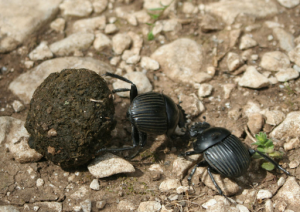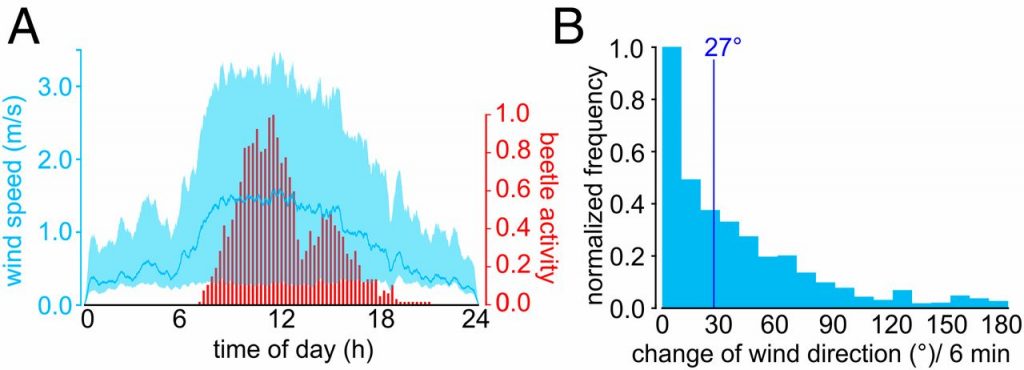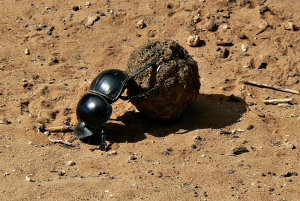Finding a dung pile is like Black Friday in the savannas of South Africa for the dung beetle. When the beetles find a pile of dung, it’s every beetle for themselves as they cut off pieces of the nutrient-rich reward. Like snagging that last 50%-off flat-screen in a crowd of crazed Christmas shoppers, the beetles will take their dung and roll off to get away from other hungry competitors.

Two dung beetles fighting over a ball of dung (Wiki)
The South African ball-rolling dung beetle exhibits a unique orientation behavior in their bolt to avoid competition for food: once their piece of dung is rolled into a ball, they escape along a randomly chosen straight-line path until they are a safe distance away from their opponents. But how do these beetles maintain their constant bearing? Many insects rely on multiple sensory modalities to navigate. For example, some species of moths use a combination of visual and magnetic cues in their migrations (Dreyer et al. 2018) and desert ants rely on visual and olfactory cues to steer toward their homes (Huber & Knaden 2017).
Researchers have been looking closely into the sensory modalities employed by dung beetles that improve their orientation precision. Previous research has shown that these animals use celestial cues, such as the sun, as an orientation reference. A recent study by Dacke et al. (2019) hypothesized that dung beetles use wind as a guiding cue and that the beetles may integrate both sun and wind cues in the same internal compass.
To better understand the wind cue, Dacke et al. 2019 observed wind patterns in the natural habitat of diurnal dung beetles to determine if conditions are suitable for wind-based orientation (Figure 1). They found that peak wind speed is reached at the same time of day as the peak activity of the dung beetles. Further, wind direction changes very little in the short window of time that dung beetles need to orient along a bearing (~6 minutes). These observations open up the possibility that dung beetles can use wind as a precise orientation cue.

Fig 1. (A) Average local wind speeds over the course of the day (blue) in comparison with a normalized activity diagram of the S. lamarcki dung beetle (red). Peak wind and beetle activity occur around the same time of day (~12pm). (B) Change in wind direction over a 6-min period (S. Lamarcki roll their balls for only ~6-min on average). The median change in wind direction within the window period is ~27.0° (Dacke et al. 2019)
After discerning the possible use of a wind cue for orientation, the researchers wanted to explore how dung beetles may use a dynamic multimodal (e.g., sun cue and wind cue) compass to maintain a straight-line path (Figure 2). The beetles were tested in an outdoor arena under a clear sky with the sun at a range of elevations (e.g., high, medium, and low). They were then presented with a controlled, stable airflow. The direction of the airflow or the position of the sun were then changed by 180° between 2 rolls of each ball-rolling beetle. At high solar elevation (i.e., the sun at its zenith) with a 180° change in wind direction on the second roll, the dung beetles changed their orientation by 180°. At medium and low solar elevations, the same beetles did not change their bearings in response to a change in wind direction. However, at these two elevations, a change in solar position did cause a drastic change in rolling direction.

Fig. 2. The cue preference of the wind and sun compass at different solar elevations. (A) Schematic of the experimental procedure. Wind stimuli (blue) were set perpendicular to sun position (yellow circles). During their first roll, the beetles experienced the sun and wind from a certain direction. In the control conditions, both cues remained in those positions during a second roll. In the test conditions, either the wind or the sun was displaced by 180°. (B-D) Circular plots show the change in heading between 2 consecutive rolls based on the elevation of sun and whether the position of the wind or sun was changed on the second roll (Dacke et al. 2019)
These results demonstrate that dung beetles have a dynamic multimodal compass system. The interplay between the sun compass and wind compass modalities change with sensory input: the wind compass dominates at high solar elevations and the sun compass dominates as the sun draws closer to the horizon. This makes sense, because skylight cues are more difficult to read when the sun is at its zenith, so it is helpful to have another cue on which they can rely. Having a dynamic control system possibly allows the dung beetles to orient based on the most reliable cue at any given moment in time. This was especially evident as the researchers observed that wind improved the orientation precision of beetles at high solar elevations.

Dung beetle rolling its ball of dung away from competitors (Wiki)
Finally, the researchers wanted to understand how information is transferred between the wind and sun compasses. It was found that dung beetles combine and store available sun and wind cues in the form of an internal snapshot and orient in reference to this. In fact, beetles have shown the ability to transfer directional information from one modality to another in order to maintain their heading direction.
Overall, the results of the study suggest that the visual (sun) and mechanosensory (wind) compasses of dung beetles converge in the same memory network in the brain and are weighted based on the relative precision of the sun compass. The spatial memory of the dung beetles based on sun and wind cues allows the animal to rely on the most reliable cue at any time in order to most efficiently escape from food competitors. This work is important in understanding how dynamic sensory networks can evolve in relationship to an animal’s environment so that they can most adequately compete for resources.
References
Dacke, M., Bell, A., Foster, J., Baird, E., Strube-Bloss, M., Byrne, M., Jundi, B. 2019. Multimodal cue integration in the dung beetle compass. Proceedings of the National Academy of Sciences of the United States of America, vol. 116 (28), 14248-14253. https://doi.org/10.1073/pnas.1904308116
Dreyer, D., Frost, B., Mouritsen, H., Gunther, A., Green, K., Whitehouse, M., Johnsen, S., Heinze, S., Warrant, E. 2018. The Earth’s magnetic field and visual landmarks steer migratory flight behavior in the nocturnal Australian bogong moth. Current Biology, vol. 28(13), 2160-2166.
Huber, R. and Knaden, M. 2017. Homing ants get confused when nest cues are also route cues. Current Biology, 27(23), 3706-3710.
